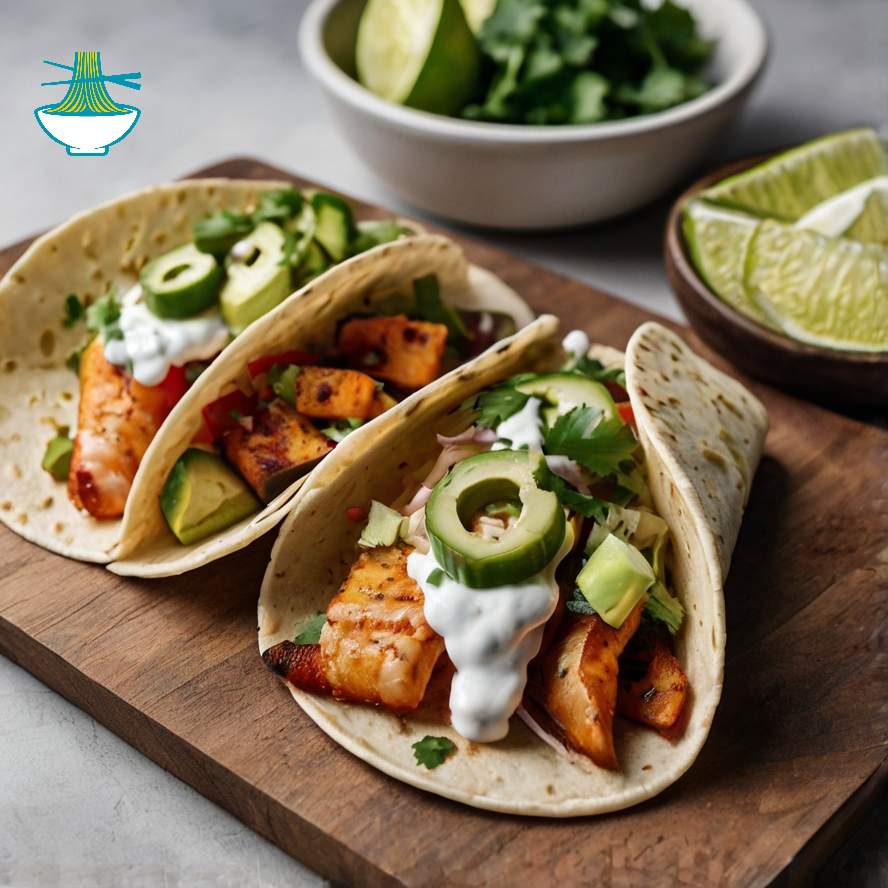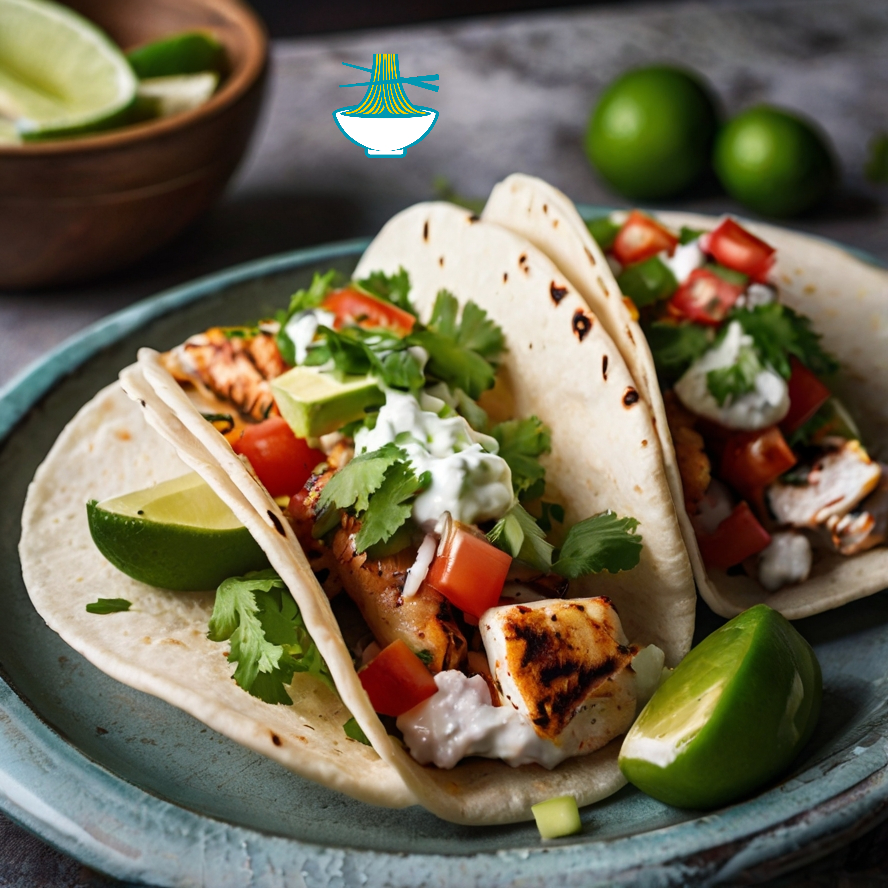Fish Tacos are a delightful meal that combines the natural goodness of fresh, grilled fish with the versatility of tacos. Fish, especially varieties like cod or mahi-mahi, is a rich source of lean protein, omega-3 fatty acids, and essential vitamins like D and B12, promoting heart and brain health. While the fish provides numerous health benefits, the toppings—such as cabbage slaw and creamy sauces—add a balance of flavors and nutrients. However, moderation is key, especially when using high-calorie sauces. Fish Tacos are a wholesome, flavorful, and customizable dish that satisfies cravings while offering nutritional value.
Ingredients:
- 1 lb fresh fish fillets (e.g., cod, mahi-mahi, or tilapia)
- 2 tablespoons olive oil
- 1 teaspoon paprika
- 1 teaspoon chili powder
- 1/2 teaspoon garlic powder
- 1/2 teaspoon cumin
- Salt and black pepper to taste
- 8 small tortillas
- 1 cup shredded red cabbage
- 1/2 cup diced tomatoes
- 1/2 cup chopped fresh cilantro
- 1/4 cup sliced red onions
- 1/2 cup sour cream or yogurt
- Juice of 1 lime
- Hot sauce (optional)
Instructions:
Preheat the Grill
- Start by preheating your grill or stovetop grill pan to medium heat. This ensures the fish cooks evenly, developing a beautiful grilled flavor.
Prepare the Marinade
- In a small mixing bowl, combine 2 tablespoons of olive oil, 1 teaspoon of paprika, 1 teaspoon of chili powder, 1/2 teaspoon of garlic powder, 1/2 teaspoon of cumin, salt, and black pepper to taste. Stir the ingredients together until they form a smooth marinade. The olive oil helps the spices stick to the fish, while the paprika and chili powder provide a smoky kick.
Marinate the Fish
- Use a brush or spoon to evenly coat the fish fillets (such as cod, mahi-mahi, or tilapia) on both sides with the marinade. Allow the fish to sit for 5–10 minutes to soak in the flavors. Marinating the fish helps enhance the taste, so don’t rush this step.
Grill the Fish
- Place the marinated fish fillets onto the preheated grill or stovetop grill pan. Grill the fish for about 3–4 minutes per side, or until the fish flakes easily when tested with a fork. The fish should have a light golden-brown crust with a tender, juicy interior. If using a stovetop pan, you can also check the doneness by pressing the fillet lightly with a spatula—if it feels firm, it’s ready.
Warm the Tortillas
- While the fish is grilling, warm your small tortillas (about 8) on the grill or stovetop. Heat them for about 30 seconds on each side or until lightly toasted. This will give the tortillas a slight crispness and make them easier to fold without breaking.
Assemble the Tacos
- Once the fish is grilled and the tortillas are warm, flake the fish into bite-sized pieces using a fork. Carefully place the fish pieces into each tortilla, spreading them evenly to create a solid base for the toppings.
Add the Toppings
- Top each taco with shredded cabbage, diced tomatoes, chopped fresh cilantro, and sliced red onions. These fresh ingredients not only add vibrant color but also introduce a satisfying crunch and balance to the flavor profile.
Finish with Sauce
- In a small bowl, mix sour cream or yogurt with freshly squeezed lime juice. Drizzle this creamy sauce over the toppings for a rich, tangy finish. If you enjoy a bit of heat, add a splash of hot sauce on top.
Serve and Enjoy
- Serve the fish tacos immediately while they are warm and fresh. Pair them with a side of light salad or your favorite fresh salsa for an even more delightful meal.
How to Make Fish Tacos Healthier:
Low-Fat or Lactose-Free Variations:
- For a low-fat version, you can skip the sour cream and use Greek yogurt or a plant-based yogurt alternative. You could also use a lighter dressing or a homemade avocado-based sauce for a healthier alternative.
- If you're avoiding lactose, replace the sour cream with dairy-free yogurt or omit it altogether and top with a fresh salsa made from tomatoes, cilantro, and lime juice.
Choosing Sustainable Fish:
- Opting for sustainably sourced fish helps protect marine ecosystems and supports ethical fishing practices. Varieties such as Alaskan cod, wild-caught mahi-mahi, and Pacific salmon are great choices. Look for fish that have certifications from organizations like the Marine Stewardship Council (MSC) to ensure they are sustainably harvested.
Additional Tips for Healthier Preparation:
- Grilling vs. Frying: Grilling the fish instead of frying it reduces the amount of added fat, making the dish much healthier. You can also steam the fish for an even leaner alternative.
- Whole Wheat Tortillas: Use whole wheat tortillas instead of refined flour tortillas to add more fiber to your meal, aiding in digestion and helping you feel fuller for longer.
- Fresh Vegetables: Enhance the nutritional value of your fish tacos by adding fresh, seasonal vegetables like cucumber, bell peppers, or avocados. These provide extra vitamins, minerals, and healthy fats.
Complementing the Dish:
- Pair the fish tacos with a side of light salad, such as a cucumber and tomato salad, to boost the fiber content and provide additional hydration. You could also serve them with a simple, refreshing soup like a vegetable gazpacho for a complete meal.
- For a heartier meal, consider adding a side of quinoa or brown rice. Both options are high in fiber and provide a nice contrast to the light, fresh flavors of the fish tacos.
Frequently Asked Questions (FAQs):
Can I Substitute the Fish with Other Meats?
- Yes, you can substitute the fish with meats like chicken, ground beef, or pork. However, keep in mind that fish, especially varieties like cod or mahi-mahi, provide heart-healthy omega-3 fatty acids, which have unique health benefits not found in other meats.
Can I Make Fish Tacos Without Using Oil?
- Absolutely! Instead of frying the fish, you can grill it or steam it for a healthier option. Both methods will keep the fish tender while eliminating unnecessary fats. Additionally, grilling adds a delicious smoky flavor to the fish.
What Are the Best Types of Fish for Tacos?
- The best fish for tacos are mild-flavored, firm fish that can hold up well on the grill or stovetop. Popular choices include mahi-mahi, cod, and tilapia. These fish have a tender yet firm texture that makes them perfect for tacos.
How Can I Make This Recipe Healthier?
- To make your fish tacos healthier, reduce the use of heavy, high-calorie sauces. Consider swapping sour cream for low-fat Greek yogurt or a plant-based yogurt alternative. Additionally, opt for whole grain tortillas to increase the fiber content, which will help with digestion and keep you feeling full.
Can I Make Fish Tacos Suitable for People with Allergies?
- Yes, you can easily modify this recipe to accommodate various dietary restrictions. If you're cooking for someone with lactose intolerance, simply replace sour cream with lactose-free alternatives like almond yogurt or soy yogurt. For gluten allergies, you can use gluten-free tortillas to ensure everyone can enjoy the meal.
How Can I Improve the Nutritional Value of Fish Tacos?
- To improve the nutritional profile, you can add more vegetables like cabbage, tomatoes, or cilantro for extra vitamins and fiber. You could also include a variety of colorful vegetables such as bell peppers, carrots, and spinach for added antioxidants and nutrients.

Nutritional Values and Benefits
Nutritional values for all ingredients of Fish Tacos and benefits:
1. Fresh Fish Fillets (1 lb)
- Calories: 400
- Protein: 88g
- Fat: 4g
- Omega-3s: 2g
Nutritional Benefit: Fish is a great source of lean protein and omega-3 fatty acids, which support heart and brain health while reducing inflammation.
2. Olive Oil (2 tablespoons)
- Calories: 240
- Fat: 28g
Nutritional Benefit: Olive oil is rich in monounsaturated fats and antioxidants, promoting heart health and reducing bad cholesterol.
3. Red Cabbage (1 cup)
- Calories: 22
- Fiber: 2g
- Vitamin C: 36mg (60% DV)
Nutritional Benefit: Red cabbage is high in vitamin C and antioxidants, boosting immune health and reducing oxidative stress.
4. Tortillas (8 small)
- Calories: 640
- Carbohydrates: 104g
- Fiber: 16g
Nutritional Benefit: Tortillas provide energy from carbohydrates and fiber for digestion. Whole-grain varieties are more nutritious.
5. Tomatoes (1/2 cup)
- Calories: 15
- Vitamin C: 12mg (20% DV)
Nutritional Benefit: Tomatoes are a good source of vitamin C, potassium, and lycopene, supporting heart health and skin vitality.
6. Fresh Cilantro (1/2 cup)
- Calories: 2
Nutritional Benefit: Cilantro contains antioxidants and vitamins A and K, which promote detoxification and bone health.
7. Red Onions (1/4 cup)
- Calories: 16
Nutritional Benefit: Red onions are rich in quercetin, an antioxidant that reduces inflammation and supports cardiovascular health.
8. Sour Cream or Yogurt (1/2 cup)
- Calories: 120
- Protein: 6g
Nutritional Benefit: Sour cream or yogurt provides calcium and probiotics that improve gut health and support bone strength.
9. Lime Juice (1 lime)
- Calories: 11
- Vitamin C: 19mg (30% DV)
Nutritional Benefit: Lime juice is packed with vitamin C and aids digestion while enhancing the flavor of dishes.
Merged Nutritional Benefits: Fish Tacos are a nutritious meal packed with lean protein, heart-healthy fats, and essential vitamins like C and D. The dish offers balanced carbohydrates for energy, antioxidants for reducing inflammation, and probiotics for gut health. This flavorful combination makes it a wholesome choice for a quick and healthy meal.
Nutritional Benefits of Fish Tacos:
- Heart-Healthy Omega-3s: Fish like cod and mahi-mahi are excellent sources of omega-3 fatty acids, which support heart health by reducing cholesterol levels and inflammation in the body.
- Lean Protein: The fish used in the recipe is a great source of lean protein, which helps to build and repair muscle tissue, while also contributing to overall body functions.
- Antioxidants and Fiber: Ingredients like red cabbage, tomatoes, and cilantro are high in antioxidants that help combat oxidative stress and support immune health. The fiber from vegetables and whole-grain tortillas promotes digestion and keeps you feeling satisfied.


Comments